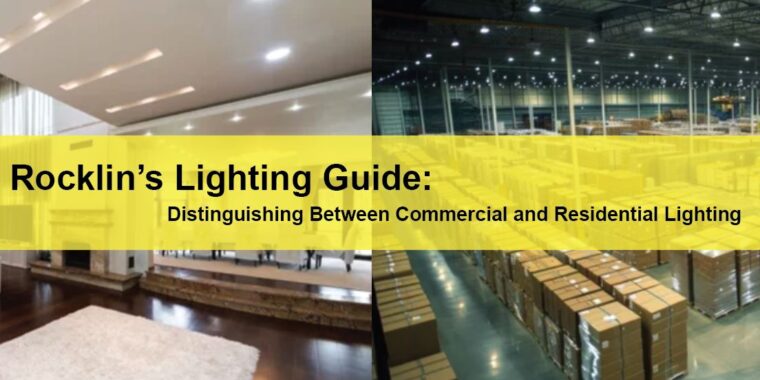Rocklin Commercial Lighting Services
Rocklin’s Lighting Guide
Distinguishing Between Commercial and Residential Lighting
LIGHTING | ELECTRICAL | PLUMBING | MECHANICAL
Northern California | Sacramento | Auburn | San Francisco | Bay Area | Reno
As LED technology continues to transform the lighting landscape, understanding the distinctions between commercial and residential lighting becomes crucial for property managers in Rocklin and the surrounding areas. While both types of lighting leverage the efficiency and longevity of LEDs, their applications, design considerations, and requirements differ significantly. This guide will help you navigate these differences and highlight how Century Commercial Service can support your commercial lighting needs.
What Are LED Lights?
LED (Light Emitting Diode) lights are a cutting-edge technology that converts electrical energy into light through semiconductors. Unlike traditional incandescent bulbs, LEDs operate without heating a filament, resulting in greater efficiency and longevity. This technology is beneficial for both commercial and residential applications, but the specific needs and preferences for each setting vary.
Commercial Lighting: Purpose and Features
Definition and Functionality: Commercial lighting is tailored to meet the demands of business environments and public spaces. It emphasizes functionality, durability, and efficiency to support various operational needs.
Types of Commercial LED Lights:
- High Bay Lights: Designed for large spaces like warehouses, these lights provide powerful illumination and are built to withstand the rigors of industrial environments.
- Panel Lights: Ideal for offices and conference rooms, offering uniform light distribution to reduce glare and improve visibility.
- Flood Lights: Used for outdoor security and area lighting, ensuring safety and visibility in parking lots and building perimeters.
- Tube Lights: Common in commercial settings such as parking garages and retail spaces, providing consistent, energy-efficient lighting.
Applications in Commercial Settings:
- Offices: Task and ambient lighting enhance productivity and create a comfortable work environment.
- Retail Stores: Lighting enhances product displays and attracts customers, playing a crucial role in merchandising.
- Warehouses: Bright, efficient lighting improves safety and operational efficiency in large storage areas.
- Hospitals: Reliable lighting supports medical procedures and ensures safety in various healthcare settings.
Residential Lighting: Purpose and Features
Definition and Functionality: Residential lighting is designed to create a warm and inviting atmosphere in homes. It balances aesthetics with functionality, focusing on comfort and visual appeal.
Types of Residential LED Lights:
- Bulbs: Versatile and used in various fixtures throughout the home.
- Strip Lights: Ideal for accent lighting in specific areas like under cabinets or along stairways.
- Recessed Lights: Offers a clean, modern look for general lighting and can be used in living rooms, kitchens, and more.
- Chandeliers: Decorative fixtures that add elegance and style to dining areas and living rooms.
Applications in Residential Settings:
- Living Rooms: Provides warm, ambient lighting that enhances relaxation and social interactions.
- Kitchens: Bright, focused lighting supports cooking and food preparation tasks.
- Bedrooms: Soft, adjustable lighting creates a restful atmosphere conducive to sleep.
- Bathrooms: Functional lighting supports grooming and personal care activities
Key Differences Between Commercial and Residential Lighting
- Purpose and Usage:
- Commercial: Focuses on functionality, efficiency, and durability to support various business activities.
- Residential: Emphasizes aesthetics, comfort, and creating a welcoming environment.
- Design and Aesthetics:
- Commercial: Prioritizes durability and practical functionality over design. The emphasis is on lighting that performs well under constant use and harsh conditions.
- Residential: Design plays a significant role, with fixtures often selected to match home decor and create a specific ambiance.
- Energy Consumption and Efficiency:
- Commercial: Typically requires higher energy output due to larger spaces and longer operating hours. Energy efficiency is crucial for managing operational costs.
- Residential: Generally has lower energy demands, but efficiency remains important for reducing utility bills.
- Light Output and Intensity:
- Commercial: Requires high-intensity lighting for adequate visibility and safety. Light levels are often higher to meet the needs of large spaces and specific tasks.
- Residential: Focuses on softer, adjustable lighting that can be customized for different activities and moods.
- Durability and Lifespan:
- Commercial: Lighting must endure continuous use and environmental stress. Durability and a longer lifespan are essential to minimize maintenance and replacement costs.
- Residential: While longevity is important, the focus is more on design and energy efficiency rather than extreme durability.
- Cost and Budget Considerations:
- Commercial: Higher upfront costs are often justified by long-term savings on energy and maintenance. Investment in quality lighting pays off through efficiency and reduced operational costs.
- Residential: Budget-friendly options are available, with a balance between cost and aesthetic appeal. The focus is on achieving a desirable look while managing expenses.
Choosing the Right Lighting for Your Needs
- For Commercial Lighting:
- Space Size: Larger areas require more powerful lighting solutions.
- Operational Hours: Consider energy-efficient options for extended use.
- Purpose: Ensure the lighting meets specific business needs and enhances operational efficiency.
- For Residential Lighting:
- Room Function: Customize lighting to suit the activities performed in each room.
- Aesthetics: Select fixtures that complement home decor and enhance the living environment.
- Energy Efficiency: Opt for LED lights to reduce energy consumption and costs.
Benefits of LED Lights in Both Settings
- Energy Savings: Reduced electricity use translates to lower utility bills.
- Environmental Benefits: LEDs contribute to a lower carbon footprint.
- Long-Term Cost Savings: Fewer replacements mean reduced maintenance expenses.
Common Mistakes to Avoid
- Overlooking Specific Needs: Tailor lighting solutions to the unique requirements of each space.
- Ignoring Energy Efficiency: Choose energy-efficient options to save money and reduce environmental impact.
- Neglecting Design and Aesthetics: For residential settings, balance functionality with design to create a cohesive look.
Future Trends in LED Lighting
- Innovations: Integration with smart home systems, advanced controls, and sustainable materials.
- Trends: Human-centric lighting, decorative fixtures, and enhanced outdoor solutions.
Conclusion
Understanding the distinctions between commercial and residential lighting is essential for effective property management. While commercial lighting focuses on functionality and durability, residential lighting emphasizes comfort and aesthetics. For property managers in Rocklin and surrounding areas, Century Commercial Service offers expert guidance and tailored solutions to meet your commercial lighting needs. Let us help you optimize your lighting for efficiency, performance, and cost-effectiveness.
For expert advice and solutions tailored to your commercial lighting needs, contact Century Commercial Service today. We are your trusted partner for optimizing lighting in Rocklin and the surrounding areas.
Service Regions Available: Sacramento, Roseville, Rocklin, Folsom, Elk Grove, Yuba City, Chico, Vacaville, Fairfield, Stockton, Modesto, Turlock, Pleasanton, Concord, San Jose, San Mateo, Walnut Creek, Oakland, Pinole, San Leandro, San Ramon, Hayward, Truckee, Northern Nevada, Reno, Sparks, Carson City, Central Valley




